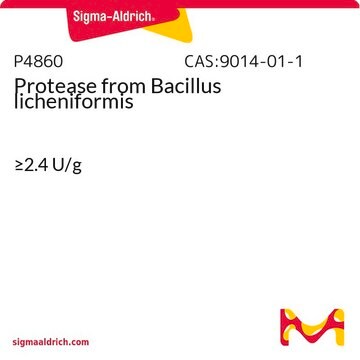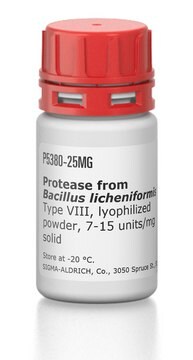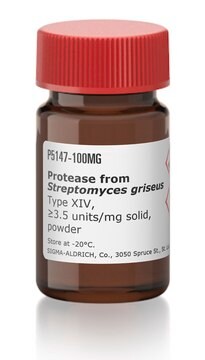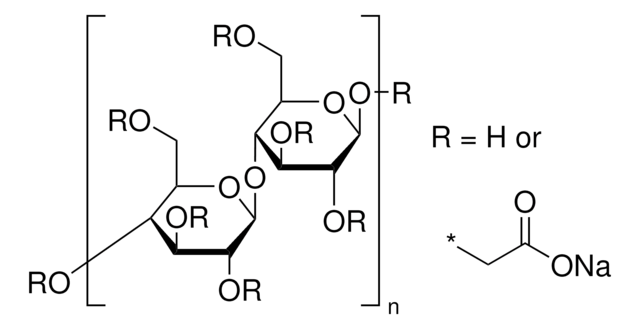P6236
Pyroglutamate Aminopeptidase from Pyrococcus furiosus
recombinant, expressed in E. coli, ~90% (SDS-PAGE), ≥5.0 units/mg protein
Sinónimos:
L-Pyrrolidone carboxyl peptidase
Iniciar sesiónpara Ver la Fijación de precios por contrato y de la organización
About This Item
Número CE:
Número MDL:
Código UNSPSC:
12352204
NACRES:
NA.54
Productos recomendados
recombinante
expressed in E. coli
Nivel de calidad
Ensayo
~90% (SDS-PAGE)
Formulario
lyophilized powder
actividad específica
≥5.0 units/mg protein
mol peso
24.072 kDa by amino acid sequence
28 kDa by SDS-PAGE
Condiciones de envío
dry ice
temp. de almacenamiento
−20°C
Categorías relacionadas
Descripción general
Pyroglutamate Aminopeptidase from Pyrococcus furiosus, also called the deblocking aminopeptidase, is a 42 kDa protein and belongs to aminopeptidase A family. It shares sequence homology with aminopeptidase in the active site, with conserved zinc and cobalt binding residues.
Aplicación
Pyroglutamate Aminopeptidase, from Pyrococcus furiosus is a recombinant, thermostable aminopeptidase that is expressed in Escherichia coli. It is used to cleave pyroglutamic acid which allows analysis of N-terminal sequences of peptides.
The enzyme from Sigma has been used for the removal of pyroglutamate (pGlu) N-terminal blocking group, under reduced conditions, prior to N-terminal sequencing of purified cassiicolin.
Thermostable aminopeptidase that liberates N-terminal pyroglutamic acid from proteins and peptides prior to Edman degradation.
Acciones bioquímicas o fisiológicas
Pyroglutamate Aminopeptidase (PGP 1) interacts with immunoglobulin, functions as inflammatory cytokine and modulates immune response. The levels PGP 1 is elevated during inflammation.
This enzyme is specific for N-terminal pyroglutamic acids. It cleaves the N-terminal pyroglutamic acid from proteins and peptides prior to Edman degradation. The optimal temperature range is 95 to 100 °C and the optimal pH range is 6.0 to 9.0.
Definición de unidad
One unit will hydrolyze 1 μmol of pyroglutamate p-nitroanilide per minute at pH 7.0 at 37 °C.
Forma física
Lyophilized powder containing sodium phosphate
Nota de preparación
Reconstitute the vial of enzyme with 50 μl of 50 mM sodium phosphate, pH 7.0, with 10 mM DTT and 1 mM EDTA. The reconstituted solution should be stored at -20 °C.
Palabra de señalización
Danger
Frases de peligro
Consejos de prudencia
Clasificaciones de peligro
Eye Irrit. 2 - Resp. Sens. 1 - Skin Irrit. 2 - STOT SE 3
Órganos de actuación
Respiratory system
Código de clase de almacenamiento
11 - Combustible Solids
Clase de riesgo para el agua (WGK)
WGK 3
Punto de inflamabilidad (°F)
Not applicable
Punto de inflamabilidad (°C)
Not applicable
Equipo de protección personal
Eyeshields, Gloves, type N95 (US)
Elija entre una de las versiones más recientes:
¿Ya tiene este producto?
Encuentre la documentación para los productos que ha comprado recientemente en la Biblioteca de documentos.
Los clientes también vieron
Frédéric de Lamotte et al.
Journal of chromatography. B, Analytical technologies in the biomedical and life sciences, 849(1-2), 357-362 (2006-11-23)
Cassiicolin, a phytotoxin produced by the necrotrophic fungus Corynespora cassiicola, was purified to homogeneity from a rubber tree isolate. The optimized protocol involves reverse phase chromatography followed by size exclusion chromatography, with monitoring of the toxicity on detached rubber tree
Pyroglutamate aminopeptidase 1 may be an indicator of cellular inflammatory response as revealed using a sensitive long-wavelength fluorescent probe
Gong Q, et al.
Chemical Science, 7(7), 4694-4697 (2016)
A Ultrasensitive Near-Infrared Fluorescent Probe Reveals Pyroglutamate Aminopeptidase 1 Can Be a New Inflammatory Cytokine
Gong Q, et al.
Advanced science (Weinheim, Baden-Wurttemberg, Germany), 5(4), 1700664-1700664 (2018)
New deblocking aminopeptidases from Pyrococcus horikoshii
Mori K and Ishikawa K
Bioscience, Biotechnology, and Biochemistry, 69(10), 1854-1860 (2005)
Marie Schaeffer et al.
Molecular and biochemical parasitology, 150(2), 318-329 (2006-10-10)
Pyroglutamyl peptidases I (PPI) are cysteine peptidases of the clan CF, family C15, which hydrolyse N-terminal l-pyroglutamyl residues (l-pGlu). The l-pGlu modification is a post-transcriptional modification that confers relative aminopeptidase resistance and, in some cases, is essential to the modified
Nuestro equipo de científicos tiene experiencia en todas las áreas de investigación: Ciencias de la vida, Ciencia de los materiales, Síntesis química, Cromatografía, Analítica y muchas otras.
Póngase en contacto con el Servicio técnico













